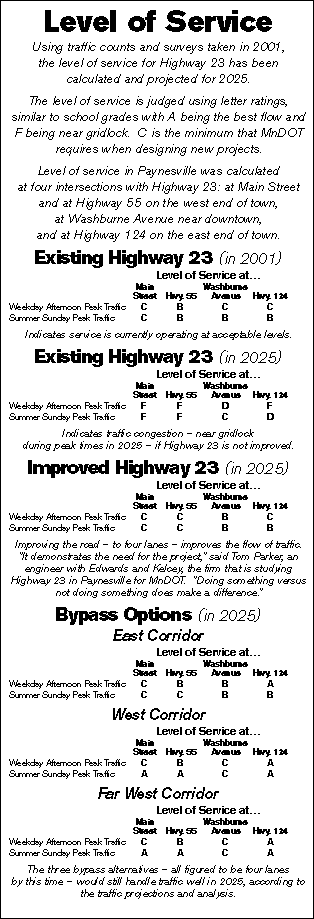Traffic analysis indicates need to improve Highway 23
 The first of several public meetings about the current study of Highway 23 was held last week, with MnDOT engineer Lowell Flaten speaking to nearly 40 members of the community at the monthly noon luncheon for the Paynesville Area Chamber of Commerce.
The first of several public meetings about the current study of Highway 23 was held last week, with MnDOT engineer Lowell Flaten speaking to nearly 40 members of the community at the monthly noon luncheon for the Paynesville Area Chamber of Commerce.MnDOT has commissioned a study to determine the future route of Highway 23 through Paynesville. "It's really important that we develop community support for the project," said Flaten, who works for the MnDOT office in Willmar and is overseeing the Highway 23 project.
Flaten traced the history of the Highway 23 project, starting with a request in the 1990s to study making Highway 23 four lanes from Willmar to I-94. A MnDOT study in 1997 showed a need for four lanes from I-94 to Richmond and from Willmar to New London and indicated traffic problems within Paynesville.
As a result of that 1997 study, Highway 23 is being widened to four lanes from I-94 to Richmond and from Willmar to New London. The current study of future routes for Highway 23 through Paynesville is also a result of that 1997 study.
An Environmental Impact Statement (EIS) is required to protect communities like Paynesville, said Flaten last week. Before these standards were required, routes could be chosen without looking at all the alternatives. Now, as required by federal law, MnDOT needs to examine alternative routes and disclose these options to the public.
So far, Edwards and Kelcey - the engineering firm completing the EIS for MnDOT - has chosen four "build" alternatives: improving the existing route, bypassing Paynesville to the south and east; bypassing Paynesville to the west; and bypassing Paynesville to the far west. (Maps of these alternative routes can be viewed at city hall.) MnDOT must always study the "no build" option to insure that the project is actually necessary.
Traffic analysis by Edwards and Kelcey, though, indicates that the project is necessary. (See chart at right)
Using traffic counts and surveys taken in 2001, the level of service (how the highway handles traffic) has been calculated for 2001 and projected for 2025. The level of service is judged using letter grades: with A being the best traffic flow, C being the minimum for a new project, and F being gridlock.
According to these standards, Highway 23 is currently handling traffic acceptably in Paynesville, with its grades for level of service being Bs and Cs. But, by 2025, the level of service will drop to Ds and Fs unless the road is improved.
By making the road four lanes, though, the level of service for 2025 becomes acceptable for all four "build" alternatives, whether improving the road through Paynesville or bypassing town.
This improvement in traffic flow "demonstrates the need for the project," said Tom Parker, an engineer with Edwards and Kelcey. "Doing something versus not doing something does make a difference." This spring, MnDOT and Edwards and Kelcey expect to hold a couple of meetings to inform the public what factors - engineering, environmental, and social - they have identified for the alternative routes. Then the EIS, which will explore these factors and determine the best route, will begin.
Flaten said local residents with concerns or opinions about Highway 23 should make them known at a public meeting or inform the city council or the local task force, which will meet regularly with the engineers.
In order to inform the public, the task force and the city will hold an informational meeting on Thursday, Feb. 27, at 7 p.m. at the Paynesville Area Center. The purpose of this meeting is to inform the public of the proposed alternative routes so people can give their feedback to MnDOT later this spring.
Contact the author at editor@paynesvillepress.com • Return to News Menu
Home | Marketplace | Community